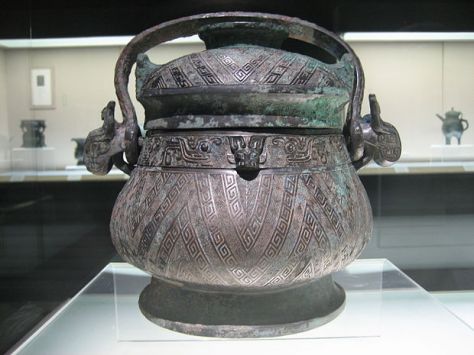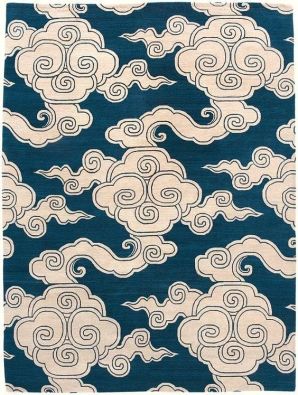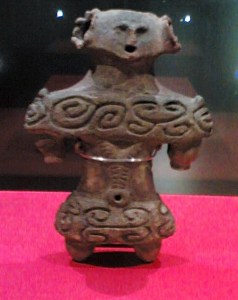Meaning of Gold Clouds in Japanese Buddhist Religious Art

(Image: Arts & crafts of Shang, Xia and Zhou dynasties)
The above white dou pottery (hollow container) from the Shang Dynasty, is decorated with an exquisite patterns of the yunwen andleiwen cloud-and-thunder combination, an elegant still usually used in Chinese designs today.
This cloud-thunder pattern is ubiquitous not only in classical Chinese compages and clothing, but in E Asian Chinese-influenced cultural spheres, like Japan and Vietnam.

Paradigm: Cloud/thunder blueprint on ritual statuary Yǒu Early Zhou dynasty, Shanghai Museum Source: Chinese ritual bronzes
Clouds are considered, particularly in Daoism, to be lucky and feature heavily in Chinese architectural ornamental details, paintings and symbolism. Information technology too sounds close to 运 yùn and and then is a homonym for 'luck, fortune, fate'. For farmers, the symbols were harbingers of pelting/thunder, and so clouds were obviously happy signs on the horizon for the imminent rains needed for watering their crops. Clouds are Daoist yin and yang symbols because they are a fusion of the elements of water and air, sky and earth.
Consequently, dragons, the masters of water and pelting, are often depicted gamboling in the clouds every bit dragons are the masters of water and pelting. A motion picture of bats flight amid clouds is a wish for adept fortune. The simplified motif class for a cloud resembles the shape of the 灵芝 líng zhī fungus (elixir of immortality). Clouds of five colors represent the five blessings of life.
Image credit: Nature symbolism
Called the ruyi, the word ruyi itself comes from the two characters rú (如) and yì (意), and together they literally hateful "as one wishes." Even so, that is only the surface meaning; the inner pregnant has been enriched over thousands of years of Chinese history.
At the first of Chinese civilisation nearly 5,000 years ago, the Yellow Emperor (the earliest known Chinese monarch), who after winning an epic boxing, named his weapon "Ruyi," implying that, literally "every bit wished" (rúyì), he was victorious in protecting the nation and establishing a culture that would terminal up to the present.
By the Tang Dynasty, the ruyi had get a symbol of power, peace, and happiness, and could be spotted in paintings and on sculptures. The Monkey King, a mythical Buddhist monk from classical literature, is known for conveying a magical staff chosen Ruyi Gold Hoop Staff.
Even today the give-and-take "ruyi" is institute in many Chinese greetings, especially those used during the Chinese New year's day, including "wànshì rúyì" (万事如意), "jíxiáng rúyì" (吉祥如意),"xìngfú rúyì" (幸福如意)—which interpret to something like "all the best" "good luck" and "best wishes."

Antique Tibetan carpeting ca. 1880 Prototype credit: 1st Dibs
The motif spread across Eastern asia, as popular Buddhist pattern woven on luxury Tibetan rugs and embroidered on Chinese clothing. Fifty-fifty today, the cloud-thunder meander pattern remains a common pattern in Chinese pottery design while the cloud blueprint is too a pop motif in Nihon in many diversified many forms on kimonos and wearable fabrics.

Prototype credit: 雲デザイン by Cantlet Suzuki
Earliest origins of the motif
Equally mentioned earlier, the earliest Chinese motifs are known from Shang potteries or bronzes. What is tantalizing to consider, is that the cloud motif may have been a motif that had disseminated from the earliest prehistoric progenitors of E Eurasian-Northeast Siberian populations who so spread out beyond Eastern asia.
The Ainu take as one of their creation myths, a descent from sky a deity upon a five-colored cloud:
" … the world was created when oil floating in the ocean rose like a flame and became the heaven. What was left turned into land. Vapor gathered over the land and a god was created. From the vapor of the sky, some other god was created who descended on five-colored clouds. Out of those clouds, the two gods created the sea, soil, minerals, plants, and animals. The two gods married and produced many gods including two shining gods—the Sun god and the Moon god, who rose to Heaven in order to illuminate the fog-covered nighttime places of the world."
When y'all consider that the Ainu descend from a people who are genetically a "deep co-operative of Due east Asian diversity that is more than basal than all present-day Eastward-Asian farmers" (Jeong 2016) i.e., ane of the earliest people at the root of the Due east Asian genetic tree and have been relatively isolated on the Japanese archipelago, the deject motif is perhaps a motif that is more than likely to have been disseminated from an early progenitor than to have been a borrowing from the Chinese in historic times. Too according to a Jeong 2016 paper, there was early gene-flow from the Ainu into the northeast Siberian populations, including the Ulchi and Nivkh, from whom the motif accept spread to the primeval northeastern Chinese populations.
" Ainu-related ancestry is present in the Japanese and the Ulchi people from the lower bowl of the Amur River (17.viii and 13.5% mean ancestry in Effigy 2, respectively), as well as in two Nivkh individuals, an indigenous population from the Sakhalin island, in a similar analysis with additional samples (27.two% hateful ancestry; Figure S5). This suggests a potential gene flow from an Ainu-related gene pool into these surrounding populations..."

Paradigm: Japanese mythology Jomon "dogu" ceramic figurine with spiral cloud motif Photo: Heritage of Nihon archives
References:
Dissertation by Jeong 2016, THE GENETIC HISTORY AND ADAPTATIONS OF
HIGH Altitude Due east ASIANS IN THE TIBETAN PLATEAU
https://knowledge.uchicago.edu/record /579/files/ Jeong_uchicago_0330D_13448.pdf
Jeong C, Nakagome S and Di Rienzo A. 2016. Deep history of Eastward Asian
populations revealed through genetic analysis of the Ainu. Genetics 202: 261-272
The Shen Yun Shop
Nature symbolism (Chinasage.info)
howellloosearrose.blogspot.com
Source: https://japanesemythology.wordpress.com/cloud-motif-and-its-origin/
0 Response to "Meaning of Gold Clouds in Japanese Buddhist Religious Art"
Post a Comment